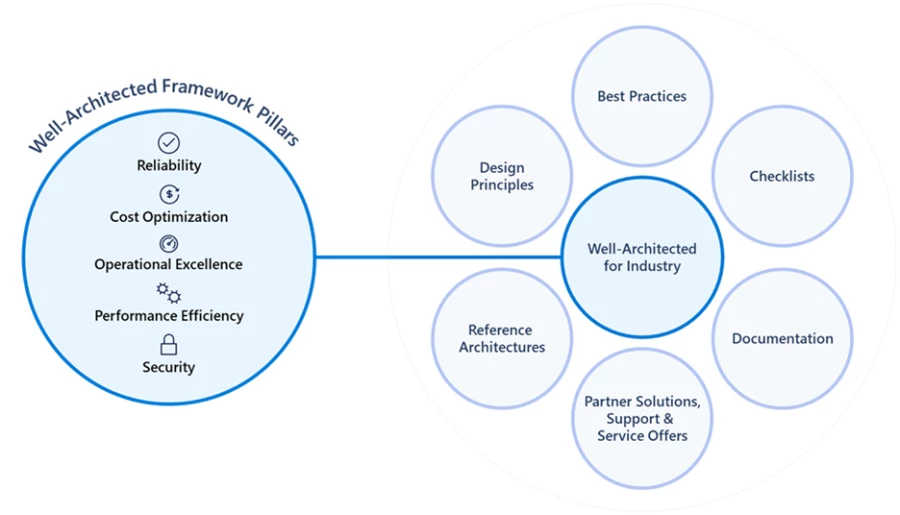Announcing Well-Architected for Industry: Improve workloads and solution deployments
As organizations look to deploy industry solutions on Microsoft Cloud, embarking on a successful solution implementation can appear overwhelming. To help our partner and customer ecosystem effectively implement new industry solutions, we are thrilled to announce Well-Architected for Industry, a set of principles that provides prescriptive guidance to improve the quality of industry solution deployments. Building on the success of the Well-Architected for Azure framework, we are starting with Microsoft Cloud for Sustainability.
Well-Architected for Industry
Guiding principles that you can use to improve the quality of your industry cloud workloads.
Guiding your Microsoft Cloud for Sustainability journey
With increasing global regulations and a push to net-zero, organizations are seeking to accelerate their sustainability progress and business growth. Microsoft Cloud for Sustainability is a comprehensive and extensible solution that brings together a set of environmental, social, and governance (ESG) capabilities from Microsoft Azure, Microsoft 365, Microsoft Dynamics 365, and solutions from our global ecosystem of partners. We recently announced Microsoft Sustainability Manager, a Microsoft Cloud for Sustainability solution, is being expanded to give customers fuller visibility into their environmental impact across carbon, water, and waste. New capabilities will help customers create a comprehensive ESG data estate and prepare them to meet new reporting requirements.
As part of the Well-Architected for Industry framework, we have curated context-relevant implementation guidance to support the entire solution development lifecycle starting from design and architecting to operational monitoring. The framework consists of five pillars of architectural excellence including reliability, cost optimization, operational excellence, performance efficiency, and security. Project Managers, Solution Architects, Developers, operational team members, and System Administrators can benefit by applying these pillars to their workloads.

The Well-Architected for Industry framework is intended to provide substantial benefits to partners and customers. For instance, a partner hired to configure Microsoft Sustainability Manager can leverage the framework to design reliable and scalable architecture to build their customer’s carbon emission calculations and reporting workloads. By incorporating security practices, the partner can ensure robust data protection and compliance with industry standards. Additionally, the framework’s performance optimization guidance enables the partner to enhance the application’s responsiveness and user experience. The framework also assists in establishing effective governance and operational processes, ensuring visibility and control over the application’s infrastructure. Ultimately, the partner can deliver a successful solution to their customers, meeting their requirements while adhering to best practices and industry guidelines.
“As a trusted implementation partner of Microsoft Cloud for Sustainability, we see benefits for our clients using the Well-Architected for Industry approach. By leveraging these guidelines, KPMG can deliver more efficient and innovative implementations, enabling our clients to accelerate their path to enterprise environmental insights and improved sustainability reporting.”—Rob Fisher, Global ESG Advisory Leader, KPMG.
Reference architecture
Reference architectures are a viable starting point during the initial solution modeling and design sessions and paint the holistic picture of the core components of Microsoft Cloud for Sustainability. As an example, a Solution Architect can leverage the reference architecture for Microsoft Sustainability Manager to identify the required data ingestion strategies and extensibility needed for emission calculations. Further, reference architecture can be leveraged to identify the project tasks, and bill of materials during the estimation phase of the implementation. For an IT admin, the reference architecture provides a detailed view into the components that need to be managed and maintained by the customer through their processes such as user permissions, and the components that are self-managed by the system such as the analytics data lake and dataverse components.
We have launched reference architecture for Microsoft Sustainability Manager and the Emissions Impact Dashboard for Microsoft Azure and Microsoft 365. These guidelines also provide guidance on security, user interface, analytics, and integration—including a clear sense of separation between extensible and managed components and capabilities.

Design principles
The Well-Architected for Industry framework provides a set of design principles for customers and partners to align their implementation with exacting standards of reliable and scalable solutions. Built on the five pillars of architectural excellence, the design principles provide guidance for building sustainable and scalable solutions.
During implementation, a Project Manager, for example, can calibrate the effectiveness of the Microsoft Sustainability Manager configurations and customizations by mapping the solution design against the recommended design principles. A Solution Architect can prepare and validate the strength of their emissions calculation design by leveraging the design principles. The principles range from the effective use of role-based privileges to setting up an extract, transform, and load (ETL) strategy which can help partners and customers map their final design against the design principles.
Design principles and the subsequent detailed sections on design areas can fundamentally shape the decisions made during the design process of the Microsoft Cloud for Sustainability Workloads.
Learn more about design principles for Microsoft Cloud for Sustainability.
Best practices and go-live checklists
To further assist in the deployment of Microsoft Cloud for Sustainability, the framework provides deep guidance with go-live checklists, and best practices for every stage of design, deployment, and monitoring.
Users can use the assets to determine the approach to configuration, security, reliability, cost optimization, and how to optimize performance efficiency.
During the deployment of Microsoft Sustainability Manager—the deploy checklist can be referenced to ensure the licensing and deployment activities are planned against the checklist. It is common for partners and customers to overlook details such as allocating enough storage space or creating an environmental strategy. The detailed checklist in the Well-Architected for Sustainability framework helps project teams not only make the solution ready for go-live but also validate the design and mitigates risks across design, deploy, and monitor phases, ensuring implementation success.
Checklists and best practices provide further consistency and standardization of the design and implementation guidelines in addition to mitigating risks and adding efficiency. This is accomplished by encapsulating the best practices and lessons learned from customers and partners through their feedback.
Learn more about Deployment checklists for Microsoft Cloud for Sustainability Manager.
Learn more
Join our team at Microsoft Inspire on July 19, 2023, to learn how ESG reporting rules impact customers and create opportunities for partners like you.
Learn more about Well-Architected for Industry and Design principles for Microsoft Cloud for Sustainability.
Microsoft Inspire: CSRD and ESG session
Learn how ESG reporting rules impact customers and create opportunities for you.

The post Announcing Well-Architected for Industry: Improve workloads and solution deployments appeared first on Microsoft Industry Blogs.
Source: Microsoft Industry Blog
